Last updated on
Discover fresh and creative ideas for your entry front door opening into the kitchen because uniquely functional and stylish designs can transform this unconventional layout into a charming and efficient space.
These are my unique design concepts made using design tools. I hope you find them inspiring!
Looking to turn your entry-front-door-opens-into-kitchen design into a unique, stylish feature? This article is brimming with innovative ideas to transform your space from a simple doorway to an expression of your personal style.
Whilst there are countless known ideas floating around the internet, we’ll be offering resources to the best of the existing solutions. However, we’re also pushing the envelope with fresh ideas that will bring new angles into your home.
So, whether you’re remodeling or just in need of a little inspiration, we have you covered with our list of unique yet functional ideas that will definitely sparkle your creativity.
Let’s get started, shall we?
What's Inside
“Partition and Curtain Solution”
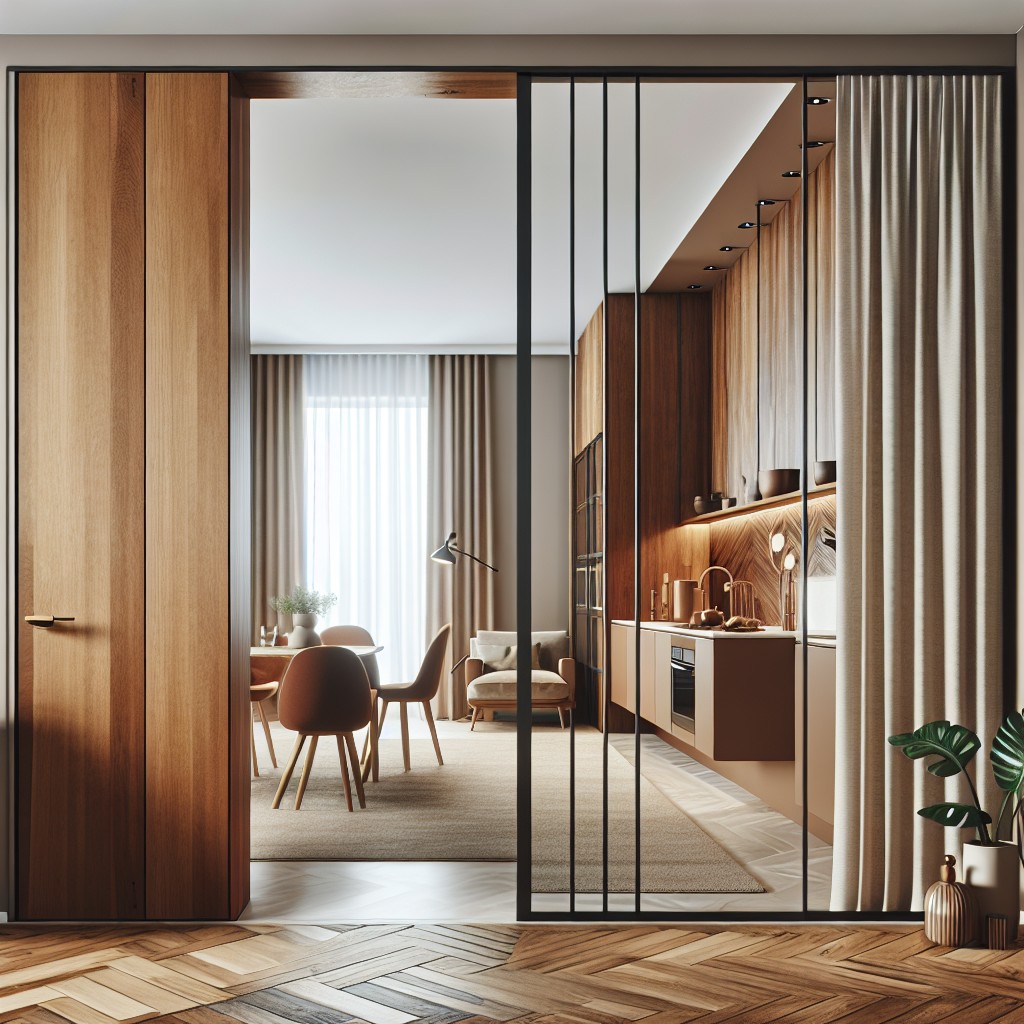
To successfully achieve a distinct divide between your kitchen and the entrance, consider installing a partial wall or a ceiling-mounted curtain that can soften the transition. The partial wall provides a structural partition without obstructing the flow, while the curtain adds a certain charm to your cozy kitchen.
Here are some tips:
- Choose a partial wall design that complements the overall décor. A stylish, inscribed wooden divider, for instance, adds a touch of sophistication.
- When using curtains, opt for light, airy fabrics to maintain a sense of openness. A semi-transparent linen curtain would be a good choice.
- The length of your curtain can either kiss the floor or dangle mid-air, depending on your taste, just ensure it doesn’t hinder movement.
- Add elements like bottom-mounted shelves on the partition wall. It creates storage space and could serve as a nice spot for showcasing décor items.
Remember, the goal is to subtly distinguish the zones without compromising on openness and continuity.
“French Door Design Entrance”
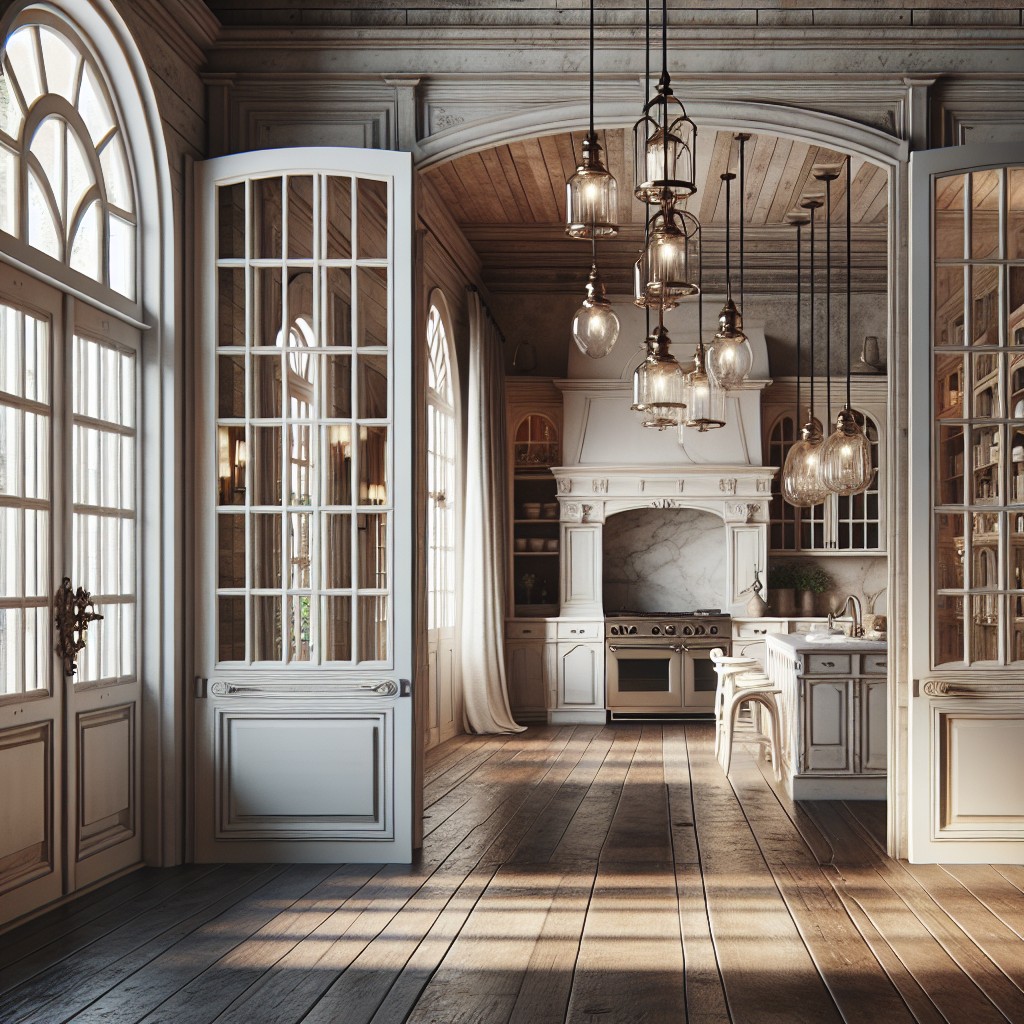
A hallmark of elegance, the French doors provides a visual connection while maintaining spatial distinction. Transparent or frosted glass panes allow natural light in, creating an airy, bright atmosphere.
For added privacy, consider using decorative films or curtains. Draw in elements of the kitchen decor to influence the door’s design. For instance, if your kitchen boasts a rustic farmhouse style, white painted wood with quaint metal handles would suit perfectly.
Simply ensure the design complements the overall aesthetic of your kitchen rather than competing with it. This approach not only effectively separates your kitchen from the entrance but also adds a sophisticated touch.
Weather stripping around the door seals, maintains indoor temperatures and prevents insects from creeping in. This ingenious design creates a stylish and functional boundary, redefining the phrase – best of both worlds.
“Integrated Mudroom Setup”
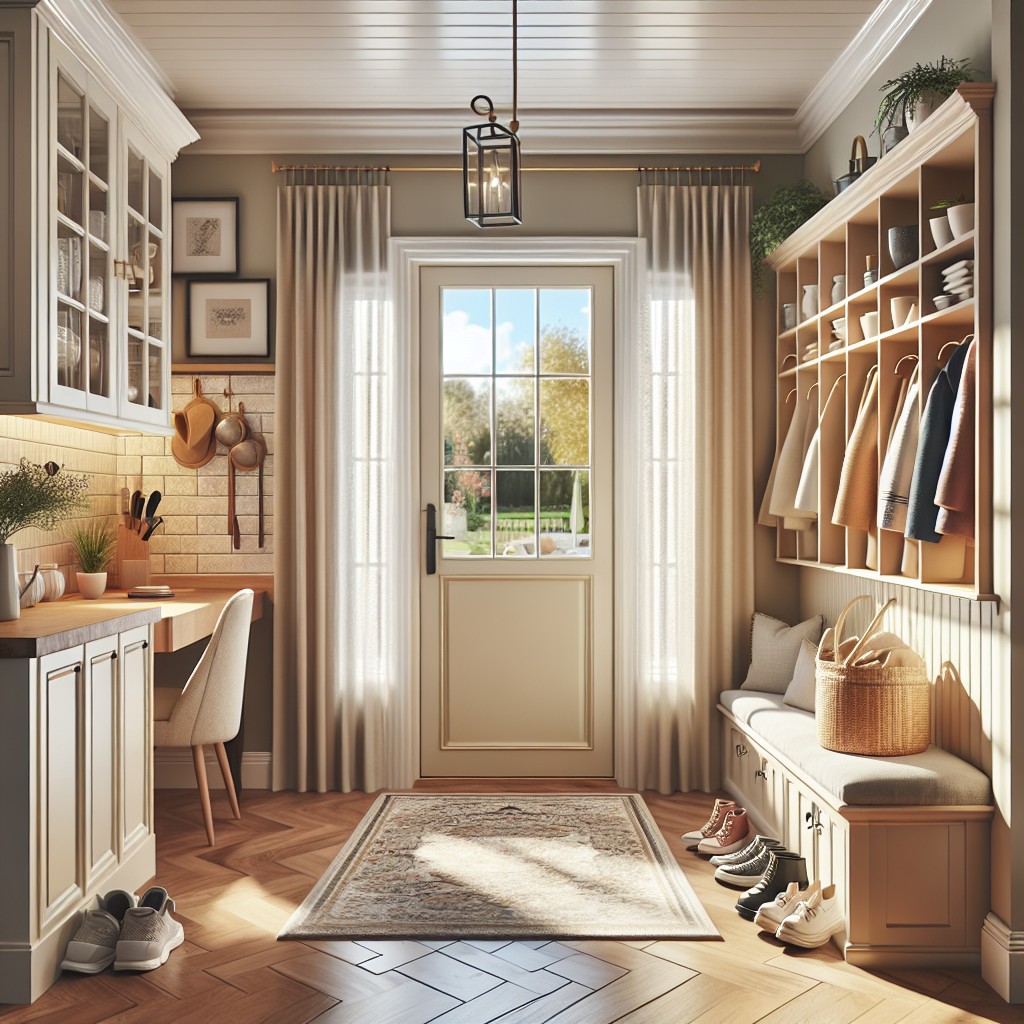
An Integrated Mudroom setup can effectively solve the problem of a front door opening directly into the kitchen. Here’s how:
- Direct Traffic: A mudroom acts as the primary entrance, directing foot traffic away from the kitchen. This reduces mess and clutter.
- Storage Capacity: Designed with purpose-built storage for coats, shoes, and accessories, it ensures these items don’t spread into kitchen space.
- Buffer Zone: It serves as a buffer between the outside weather and your kitchen. It traps dirt and debris brought in, protecting the kitchen’s cleanliness.
- Personalization: Customize the mudroom to match the kitchen décor for a seamless transition.
Remember, the size of your mudroom depends on available space. However, no matter its size, its strategic placement can vastly enhance the functionality of your home.
“Color-Zone Kitchen Theory”
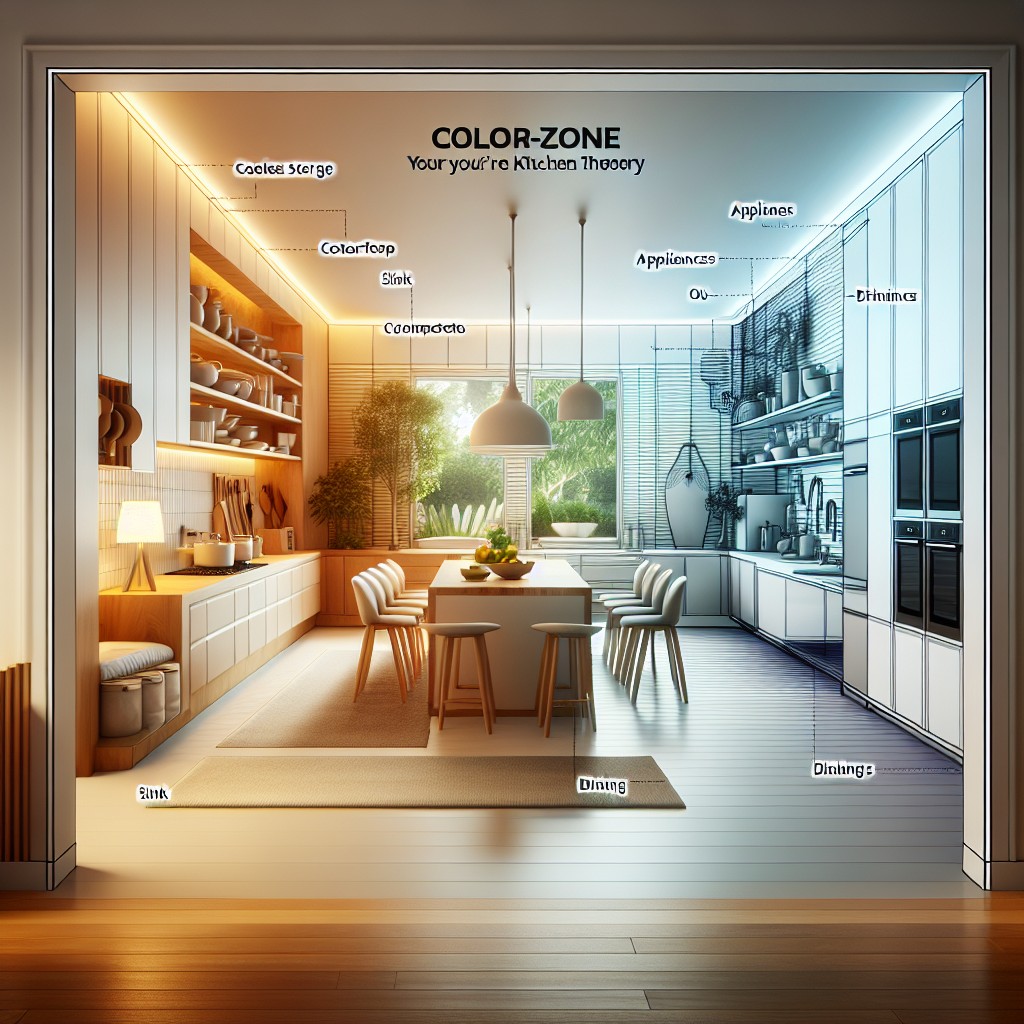
Creating different zones within your kitchen through the use of color is a great way to differentiate the entryway area. Follow these steps to successfully apply this design concept:
1. Choose contrasting but complementary colors: Select warm tones for the kitchen – perhaps yellows, reds, or earth tones. For the entry zone, cooler hues like blues and greens create a clear visual difference.
2. Coordinate with kitchen elements: Ensure the color scheme ties in with your kitchen cabinets, countertops, and backsplash.
3. Use rugs: A well-placed rug can be the final piece in defining the entryway zone. Choose a rug with a color that corresponds to the entry zone’s color scheme.
4. Paint an accent wall: This can emphasize the distinction between the entryway and kitchen even further, while adding character.
The goal here is to create a clear demarcation of spaces – the entryway area and the cooking area – without needing to resort to physical barriers. This color zoning allows the rooms to flow into each other, maintaining the area’s openness.
“Vintage Slide Door Transformation”
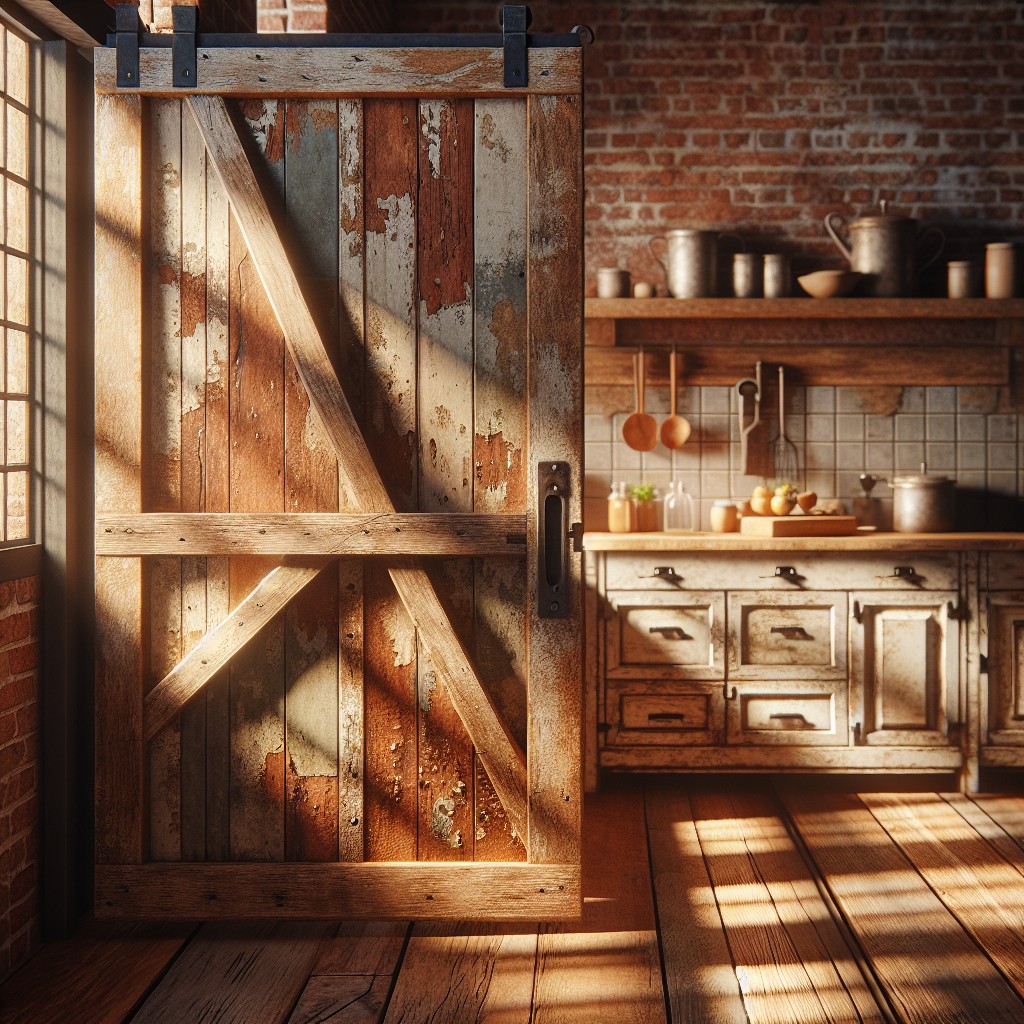
To embrace the charm of yesterday while ensuring functionality, the vintage sliding door is the perfect addition. A major benefit of this style is space-saving. They glide parallel to the wall, creating no obtrusive swings into the kitchen or entryway. Furthermore, you can choose from an array of beautiful antiquated designs, adding an extra touch of elegance.
To achieve this, consider:
- Material: Solid wood is a fantastic place to start. With its natural appeal and sturdy build, it brings authenticity to your setup.
- Hardware: Look for old-fashioned metal track systems. Brass or iron designs can offer a distinctive visual impact.
- Finish: A distressed finish can instill personality and history into the decor.
- Privacy: Incorporate frosted or stained glass if you’d like some visual separation without sacrificing the natural light.
Remember, this style transcends temporary design trends, making it a timeless addition to your home that fuses aesthetics with practicality.
“Cosy Corner Breakfast Nook”
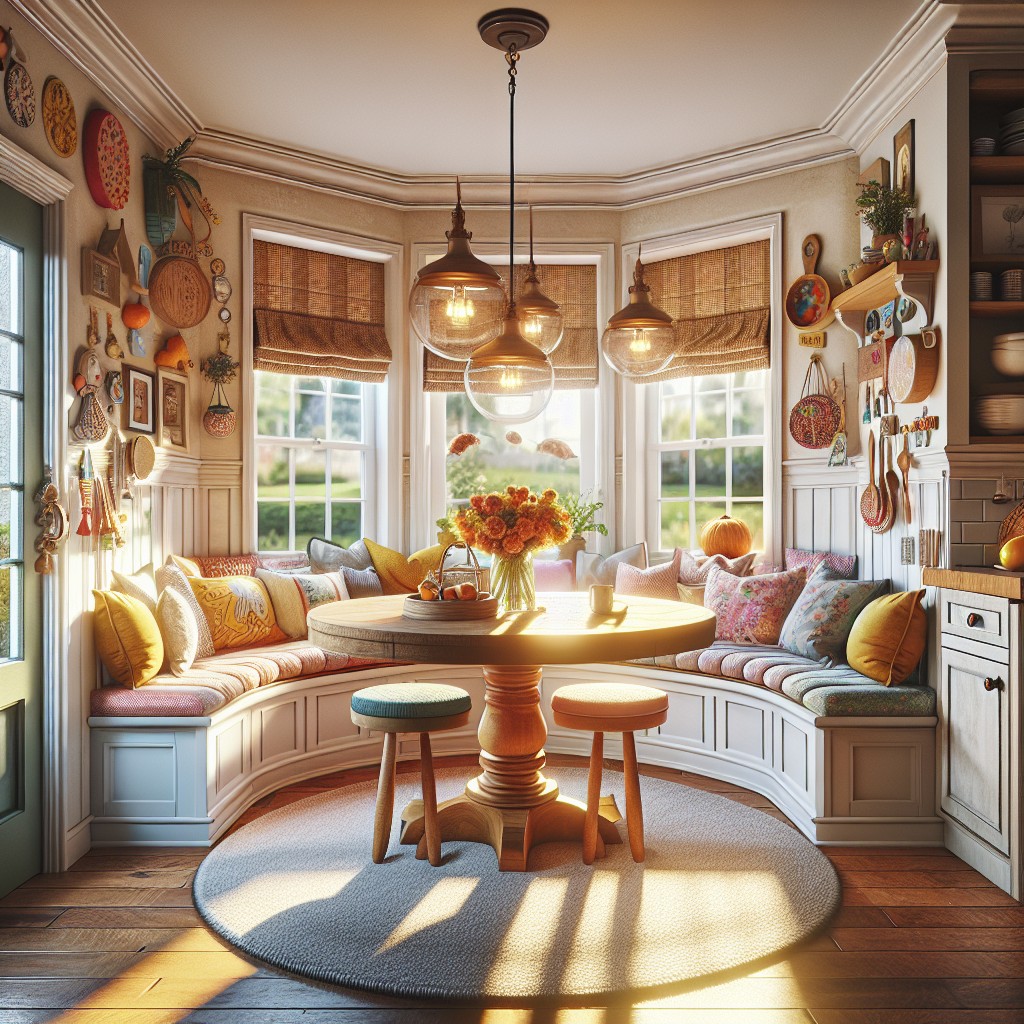
In transforming an entry-kitchen setup into a more welcoming space, the addition of a breakfast nook can work wonders. This alcove typically consists of a comfortable seating area and a small table, perfect for quick meals or a cozy coffee break.
Here are some points to guide you:
- Identify the corner: Designate a corner that does not obstruct the entryway or hinder kitchen tasks.
- Seating arrangement: Consider built-in benches or a booth-style setup for a snug feel. Cushions can enhance comfort and aesthetics.
- Table Selection: Opt for a round or square table. Make sure it fits comfortably into your chosen corner without dominating the space.
- Lighting: Natural light is ideal. If window positioning permits, erect the nook near it. A pendant light would also work for illuminating evening meals.
- Storage: Use any unused space under the seating for storage. It can hold kitchen utensils or even shoes from the entrance.
- Decor: Think cozy! Soft, warm colors and textures can give the corner a more inviting ambiance.
Remember, the goal is to use the nook to soften the transition from door to kitchen. It should function as both a practical spot for meals and a relaxing space to unwind.
“Industrial-Style Steel Frame Entrance”
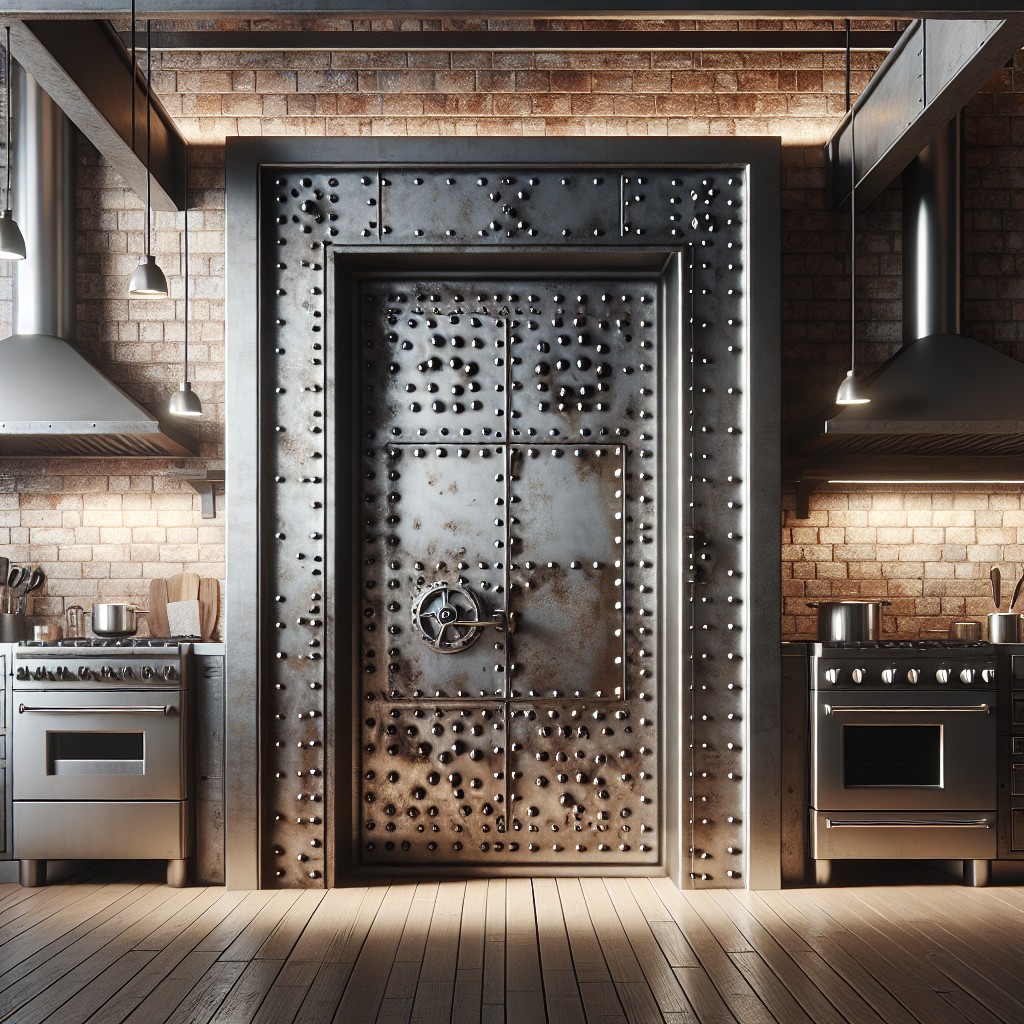
A nod to the industrial revolution, the use of steel frames delineates a clear boundary between your entryway and kitchen. Known for its durability, it combines aesthetics and functionality, turning your entrance into a striking architectural feature.
Here are a few points to consider:
- 1. It proffers the illusion of a separate room while maintaining an open-floor concept, enhancing the sense of space.
- 2. Raw materials like brick or wood nicely complement the metallic detail, lending warmth to the space.
- 3. To increase its dramatic effect, consider a floor-length, steel-framed glass door. This addition facilitates natural light flow and visually extends the space.
- 4. For a cohesive look, integrate other steel elements into your kitchen décor, like fixtures, stools, or shelving units.
- 5. If privacy is a concern, frosted or tinted glass can be a thoughtful addition. It obscures vision without compromising natural light.
Remember, in this design, simplicity is key. Stick to clean lines and subdued color palettes to allow the steel frame entrance to take center stage.
“Space-Saving Folding Door”
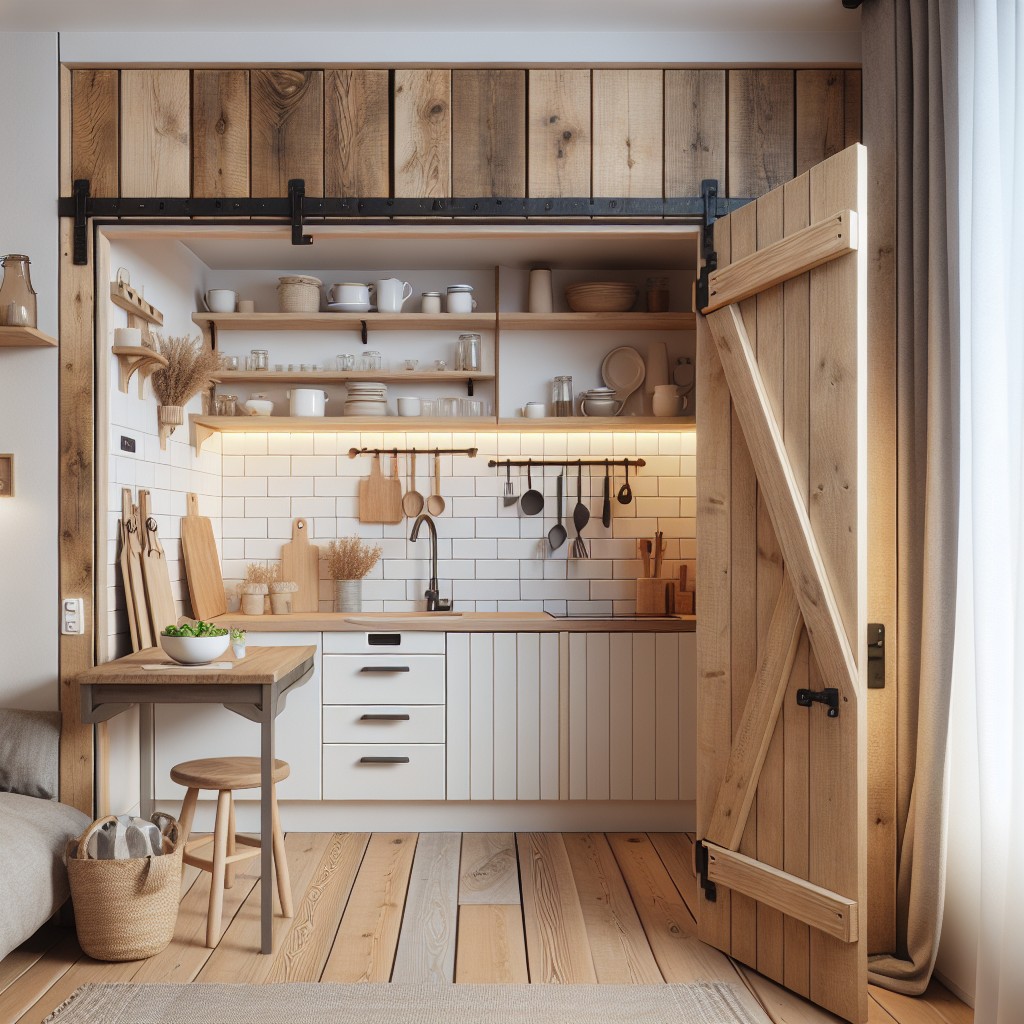
Opting for a folding door can make a world of difference in a compact kitchen. This type of door uses less space, as it folds back on itself rather than swinging out. You might think that practicality is its only strong suit, but there’s more to it!
1. Aesthetic Appeal: Available in countless styles, colors, and finishes, these doors can blend seamlessly with any interior or create an eye-catching statement.
2. Versatility: Folding doors can be partially opened or fully retracted, offering walk-through convenience or full openness to other rooms.
3. Improved Functionality: When the door is open, it creates a natural partition, providing easy access without interrupting the flow of activity in the kitchen.
4. Increase in Perceived Space: By visually connecting the kitchen to other areas, it gives an illusion of a larger, more spacious home.
Remember, folding doors can come in solid, glass, or partially glazed options. Choose a style that complements your kitchen decor and meets your personal privacy preferences.
“Doorway As Chalkboard Menus”
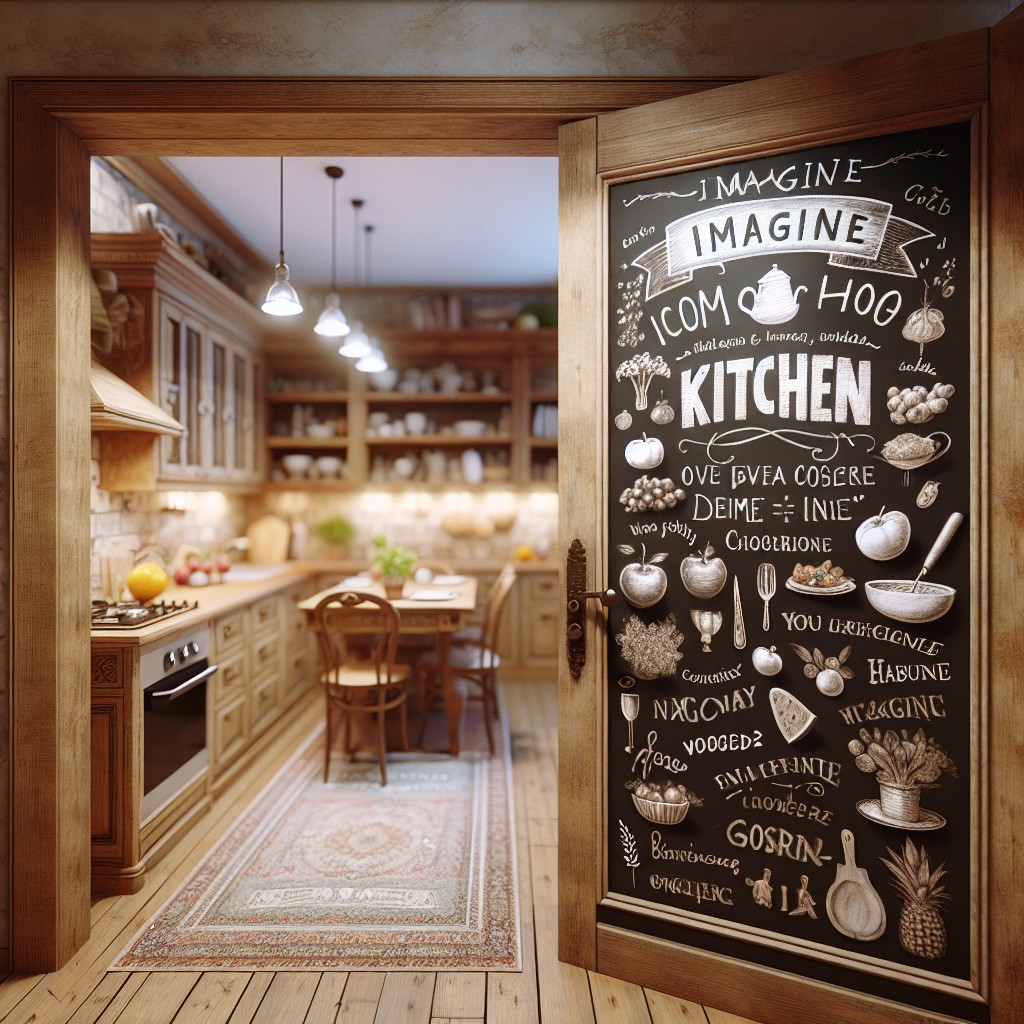
Transforming the inner side of your front door into a chalkboard menu serves both a practical and aesthetic purpose. With a coat of chalkboard paint, a spot that was once just a door now becomes an interactive space that is both engaging and purposeful.
1. Multifunctional: This idea is not just for show! It allows you to list daily meals, shopping lists, or notes for other household members.
2. Enhances Kitchen Decor: With the right kind of lettering and artistic talent, your menu can mimic those found in charming cafes or old-school bistros, adding a playful touch.
3. DIY Project: Chalkboard paint is easily accessible at most home improvement stores. Once you have a smooth, clean surface, simply apply the paint following the manufacturer’s instructions.
4. Customizable: You can change the messages daily, or seasonally – whichever suits your mood or the occasion. Use colored chalk to match the season or stick with stark white for a stylish look.
This idea showcases that with a bit of creativity, even the most unlikely elements in your kitchen can be repurposed into something functional and visually appealing.
“Glass Door for Natural Lighting”

Choosing a glass door as your kitchen entrance allows an abundance of natural light to spill into your kitchen area. This can illuminate your kitchen workspace and create an atmosphere of openness and brightness. Depending on your preference and privacy needs, you can opt for either clear, frosted, or stained glass.
The key to using a glass door effectively is to consider the direction your door is facing. South or west-facing doors are likely to let in more radiant heat, which might result in your kitchen becoming warmer, while north-facing doors will provide more diffused and consistent light.
Be mindful that a glass door will display the interior of your kitchen to visitors before they even enter. Ensure your kitchen space is tidy and aesthetically pleasing to create a good first impression.
Additional benefits of glass doors include the perception of a larger space thanks to the unobstructed view they provide, easy monitoring of outdoor activities while still indoors, and potential energy savings from reduced need for artificial light.
In summary, a glass door can offer not just an inviting entrance to your kitchen but also a functional design element that maximizes natural light and enhances your kitchen ambiance.
“Rotating Bookshelf Door Feature”
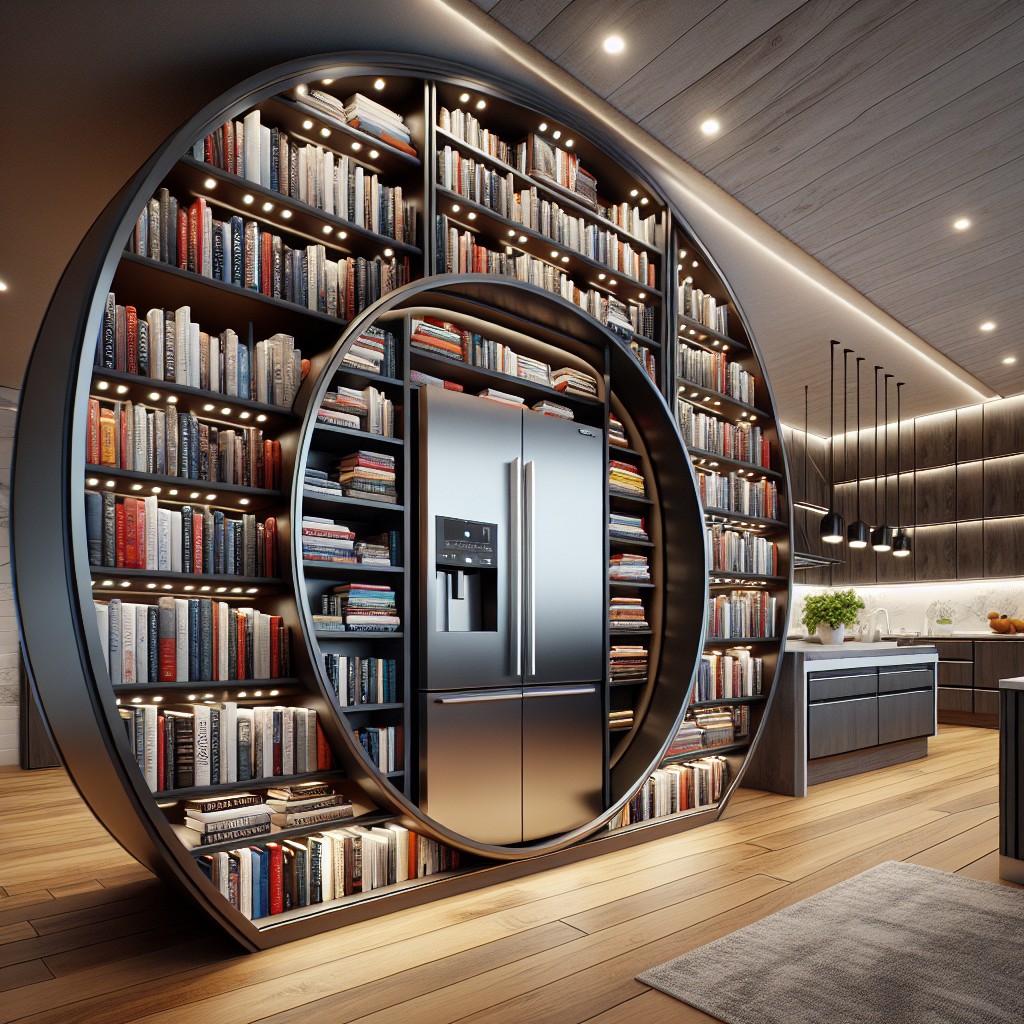
Maximizing space while bringing in the element of surprise, the rotating bookshelf door can serve as both an entryway and a smart storage solution. This design brings charisma, gives a nod to the traditional ‘hidden room’ concept, and allows for seamless transition from one area to another.
To successfully incorporate this feature, consider these points:
- Design: Opt for a sturdy built-in bookshelf design that can carry the weight of books and rotate comfortably.
- Rotation Mechanism: Reliable hardware like a pivot hinge system is crucial for smooth movement.
- Space Clearance: Ensure enough clearance for the shelf to rotate. Factor in tall or wide items placed on the shelf.
- Light Weight Objects: Use the shelves for light books or decor items to prevent heavy strain.
- Cohesion: Match the bookshelf design with the rest of the kitchen decor for visual consistency.
- Safety: Install a mechanism to lock the door in place while it’s being used as a shelf, preventing accidental rotation.
Tailored to your likes, this unique entrance brings charm and solves storage issues, affirming that functionality and style can indeed coexist beautifully in your kitchen.
“Kitchen Garden Interior Entrance”

Creating a seamless transition from your doorway to the kitchen area can be accomplished through the use of greenery. Interior kitchen gardens are not only aesthetically pleasing but also offer the added advantage of fresh herbs right at your disposal. Here’s how to incorporate this idea:
1. Choose the Right Plants: Opt for herbs like basil, parsley, and thyme that are commonly used in cooking.
2. Placement Strategy: Position the plants near the doorway where they can receive sunlight optimally.
3. Use Tiered Shelving: Consider arranging the more light-hungry plants on the top shelves and the shade-tolerant ones on the lower levels.
4. Optimal Irrigation: Design an efficient watering system to maintain the plant’s health without succumbing to overwatering.
5. Choose Decorative Pots: Use pots that match your interior décor to add to the visual appeal.
6. Be Mindful of Aroma: Certain herbs might have a strong aroma which might waft into your living space if the kitchen is directly connected to your entrance.
With these simple steps, your entrance can bloom into a lush green space, merging elegance with functionality right at your doorstep.
“Convertible Bar-Top Doorway”
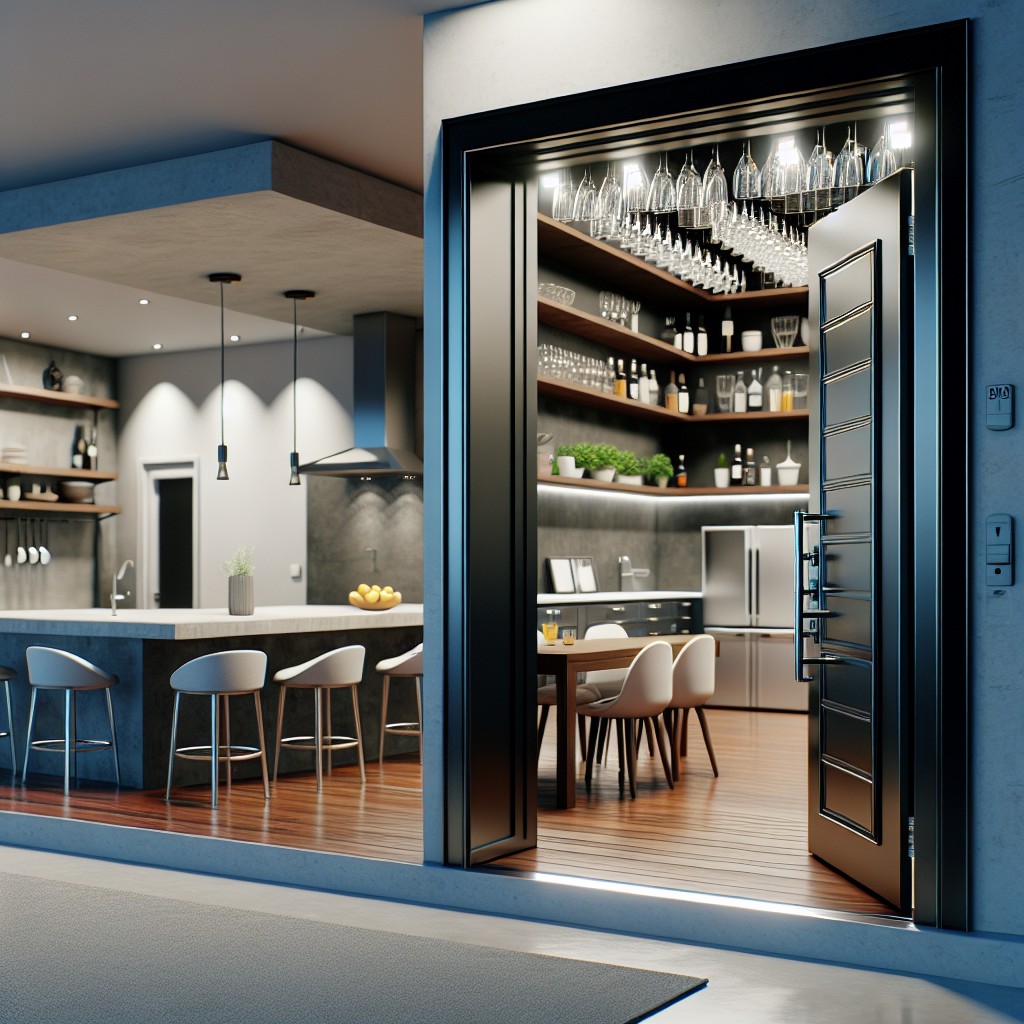
With this creative solution, you can successfully counteract the initial perceived issue of front door opening directly into the kitchen. It’s all about utilizing space effectively which simultaneously enhances the kitchen’s accessibility and utility.
Here are some points to consider:
- 1. Simply using the doorway as a bar-top can be a trendy and resourceful option. During the day, when not in use, it can serve as an additional countertop area.
- 2. Opting for materials like hardwood or marble for the bar-top can blend it seamlessly with your kitchen decor while ensuring durability.
- 3. Consider retractable designs which can help you conserve space when the bar-top is not in use and can be expanded during parties or get-togethers.
- 4. When implementing this design, it is important to place bar stools on the opposite side of the kitchen so that it does not interfere with the cooking area.
- 5. Incorporating lighting fixtures above the bar-top can transform the overall ambiance of your kitchen, making it warm and inviting.
- 6. Storage solutions such as drawers or shelves beneath the bar-top will ensure you have all your bar essentials nearby, making the area practical and handy.
Remember, this design works excellent for small homes, apartments, or open-concept floor plans. The effective utilization of space will not only make your kitchen look larger but will also create an informal, relaxed setting for guests as they step inside.
“Classic Rustic Barn-door Entrance”
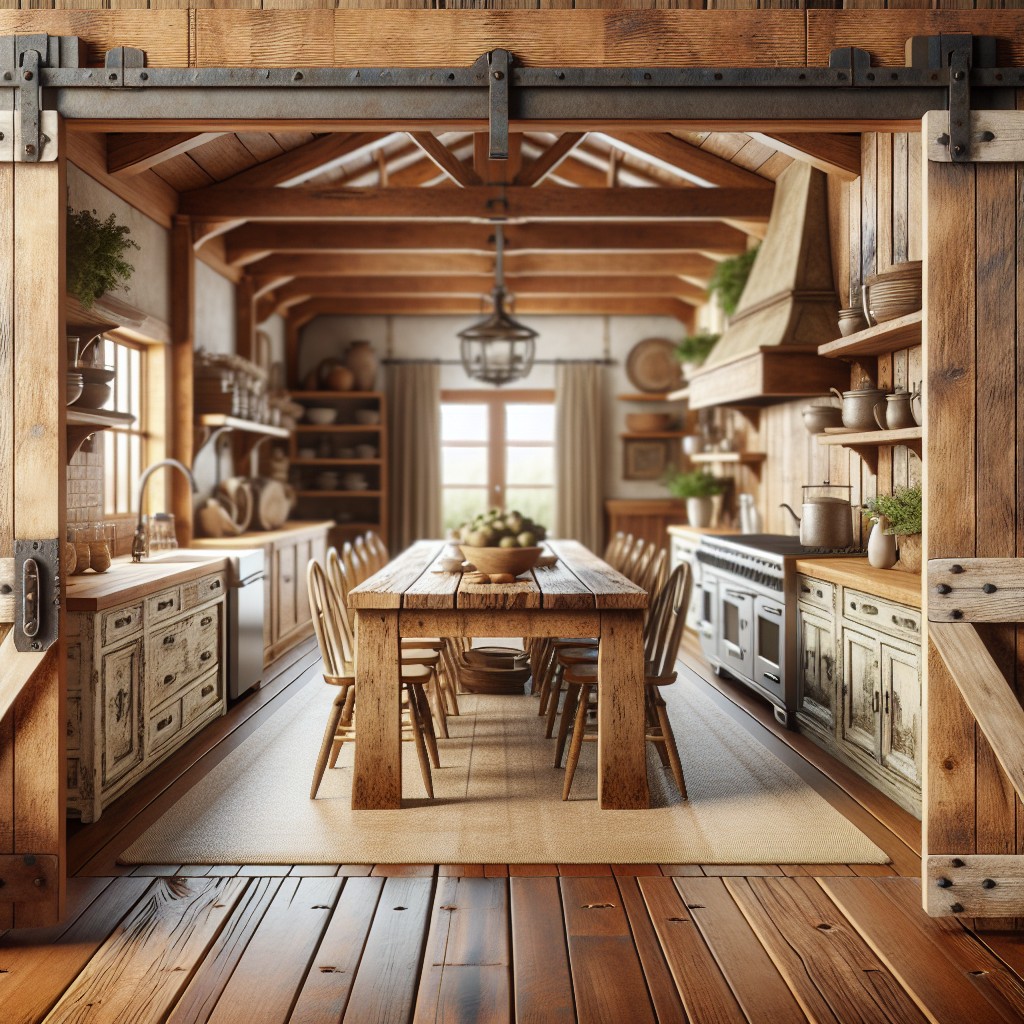
Blending both aesthetics and functionality, this style of entrance derives inspiration from countryside barns and exudes a dramatic country flair. Constructed from rich, weathered wood, the door slides effortlessly along a rail installed above, saving precious space that traditional, hinge-based doors would otherwise occupy.
To integrate this concept into the home, consider the proportion and material of your barn door. Weathered wood is standard, but contemporary versions may feature paned glass or iron. Large rolling hardware brings an added touch of authenticity.
Remember, the barn door should complement the kitchen’s overall decor. Its significant visual impact can become a focal point, so select a style and color that harmonize with your existing kitchen aesthetics. Lighter shades tend to blend more naturally and make the space feel larger, whereas a darker, bolder hue can create a stunning contrast.
Finally, it’s also worth mentioning that despite its name, a barn door doesn’t always have to exude a rustic charm. Whether your kitchen subtly hints at farmhouse vibes or embraces a modern minimalistic theme, barn doors are surprisingly versatile when combined with the right design approach.
“Hexagonal Door Modern Design”
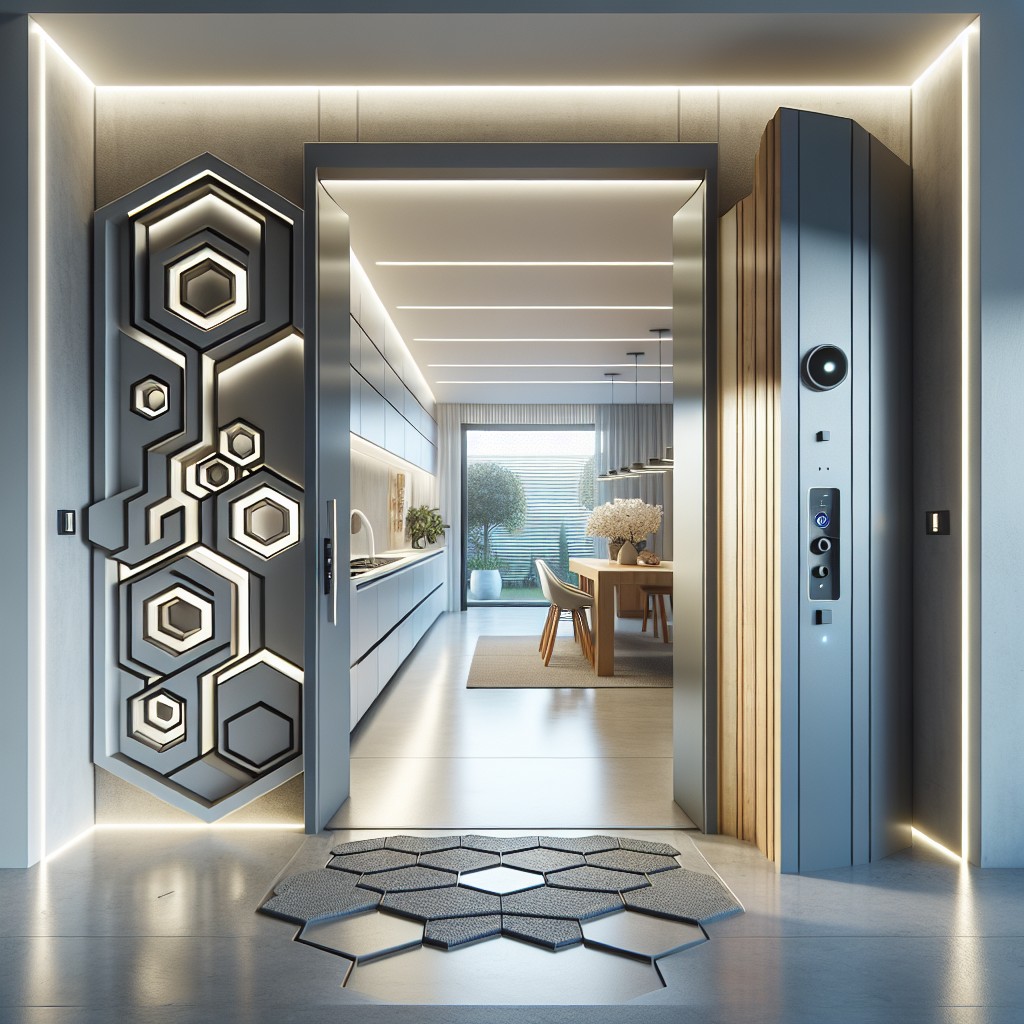
Embracing a geometric aesthetic can offer an exciting twist to traditional layouts. Creating a hexagonal entrance lends a contemporary feeling of sophistication, showing your cutting-edge preference. Its design adds an engaging visual element to an otherwise overlooked part of the home.
Here are ways to successfully execute this approach:
- Opt for a bold color to highlight the shape, such as deep navy, forest green, or even solid black that contrasts well with most kitchen themes.
- Use uniform veneer patterns for a strong, cohesive look.
- Consider including one or more glass panes for natural light flow.
- Collaborate with your architect or designer early on to ensure the design complements the overall house aesthetics.
- Weatherproof paint will preserve the door, maintaining style consistency while also ensuring longevity.
A hexagonal door can come as a refreshing change, proving that boundaries can always be pushed when it comes to design and aesthetics.
“Hidden Door Within Artwork”

Creating an entrance with the appeal of secrecy and artistic flair can be achieved effortlessly. Choosing an artwork that blends with your kitchen décor is vital for this design to maintain coherence.
Life-size canvases work best, effectively concealing the doorway behind them.
To implement this, you need:
- 1. A wide frame for the artwork which is structurally capable of supporting a door.
- 2. A door fitting team who can secure the doorway behind the artwork.
- 3. A motion sensor or subtle door handle that doesn’t interrupt the visuals of the artwork.
Consideration should be given to the artwork’s durability and it should be resistant to kitchen odors and humidity. Go bold and mysterious with this style, and let your guests marvel at your ingenious kitchen entrance.
“Minimalist Japanese Sliding Door”
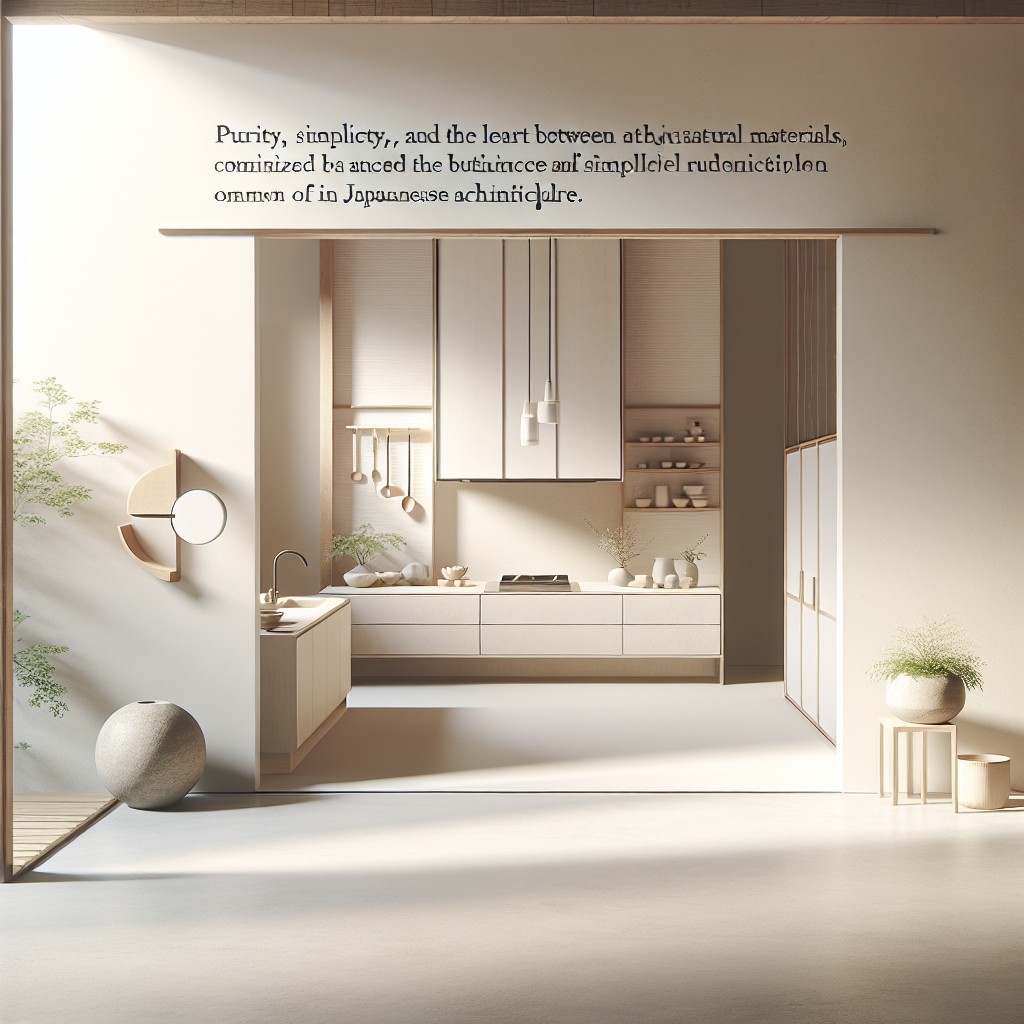
Incorporating a serene aura of Zen into your home doesn’t have to be complex. A traditional Japanese sliding door can be the perfect solution when the entry point opens directly to the kitchen area.
Bear in mind the key features:
- Lightweight: The doors, often called “Shoji”, are light and easy to handle, which makes them a practical choice for spaces with high traffic.
- Space-saving: Their sliding open and close mechanism takes no extra space, solving the problem of door swing radius in a kitchen.
- Privacy: The translucent rice paper panel filters light, adding a calming effect while ensuring privacy.
- Aesthetic: Combining natural wood with white or light coloured rice paper, these doors can beautifully enhance minimalist interior design.
This way, you not only overcome the awkward door-to-kitchen setting, but you also achieve an inviting tranquil kitchen atmosphere.
“Shabby Chic Screen Door Idea”
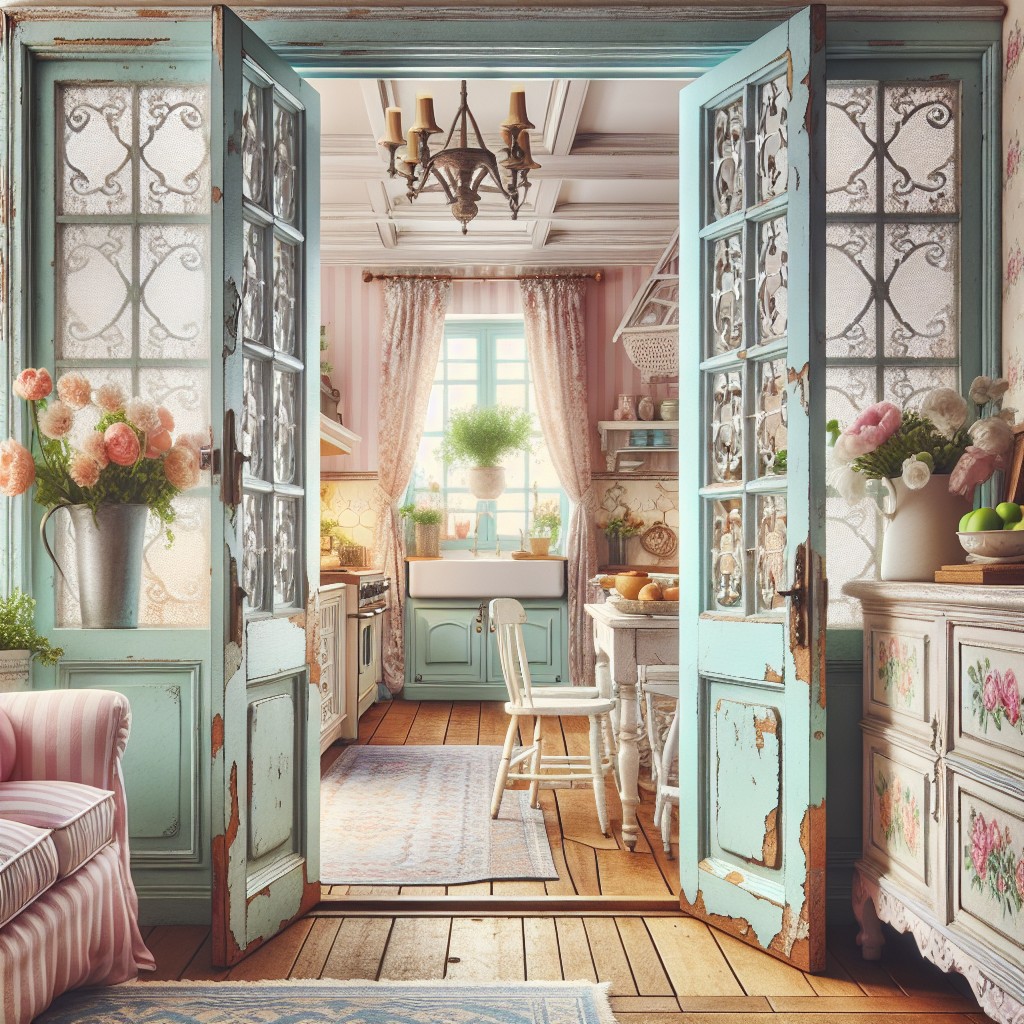
Transitioning from traditionally closed-off doors, let’s talk about incorporating screens. Drawing inspiration from back porch designs, this option breathes a refreshing and open feel into your home.
To achieve this look, start with a light-toned wood or paint finish matching your kitchen’s interior to keep harmony within the design. Distressed or weathered finishes embody the shabby chic ethos perfectly, injecting a quaint, vintage charm.
Focus on the use of lace or sheer fabrics for the door screens. These materials may be decorative, but they also help maintain some degree of privacy while still allowing light to flow through freely. Patterns bring their own touch of style, but plain allows for more versatility.
The inclusion of rustic hardware, such as iron or bronze handles, complete the offbeat elegance. Remember, embrace the imperfections; they add to the unique character!
“High-Tech Smart Door System”

Implementing cutting-edge technology to your front entrance provides both aesthetic appeal and functional advantages. A smart door system enables you to augment the aspect of security while adding a modern touch to your home.
Start with a touchless entry: A proximity sensor unlocks the door when your smartphone is near. No need to fumble for keys with hands full of groceries. Additionally, these sensors can be paired with home automation systems, allowing adjustments to lighting or thermostat settings as soon as you enter the home.
Next, consider automated locking: Set a timer to lock the door at certain times of the day, giving you peace of mind if you tend to forget such things in the rush of breakfast.
Finally, integrate your door with your kitchen appliances through an interconnected smart system. For instance, having your coffee machine start brewing as your door unlocks in the morning ensures a warm welcome into your kitchen.
Remember, while these features may seem advanced and somewhat complex, they are designed with user-friendliness in mind. With a bit of time and practice, they’ll integrate seamlessly into your daily routine.
“Beach House-style Louvered Door”
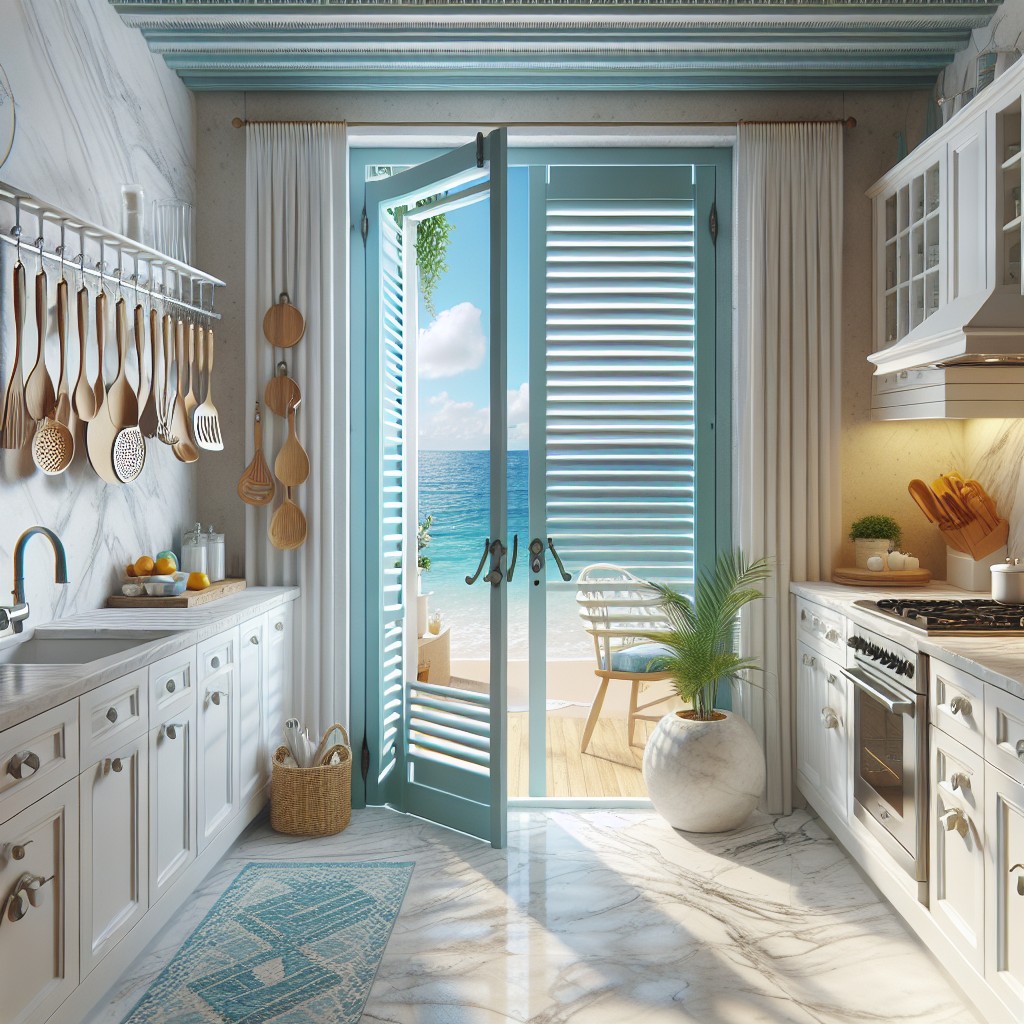
The charm of this design lies in its familial connection to holiday homes by the sea. The vertical slats, usually made of wood, permit ventilation while maintaining privacy – a perfect balance for a kitchen area.
Here’s how you can utilize this style:
- Material Choice: Opt for natural wood in lighter shades to maintain the beachy feel. Add essential treatment to ensure its resistance to potential kitchen wear and tear.
- Louvered Door Position: Position your door centrally to divide the space evenly and create balance.
- Complementing Décor: Considering décor items such as seashells, nautical colors, or wicker furniture can enhance the beach-house feel.
- Exterior Light Play: Utilize the incoming light which streams in between louvres, casting beautiful shadows that add depth and dimension to your kitchen.
Remember, the main goal is to create a relaxing and informal atmosphere, reminiscent of a serene beach house.
Ideas Elsewhere
- https://www.reddit.com/r/floorplan/comments/eq2vcf/impressions_a_front_door_entry_into_the_kitchen/
- https://www.decorpad.com/search/front-door-opens-to-kitchen
- https://www.magicbricks.com/blog/kitchen-entrance-design/121296.html
- https://www.apartmenttherapy.com/entryway-makeover-with-new-front-door-260218




